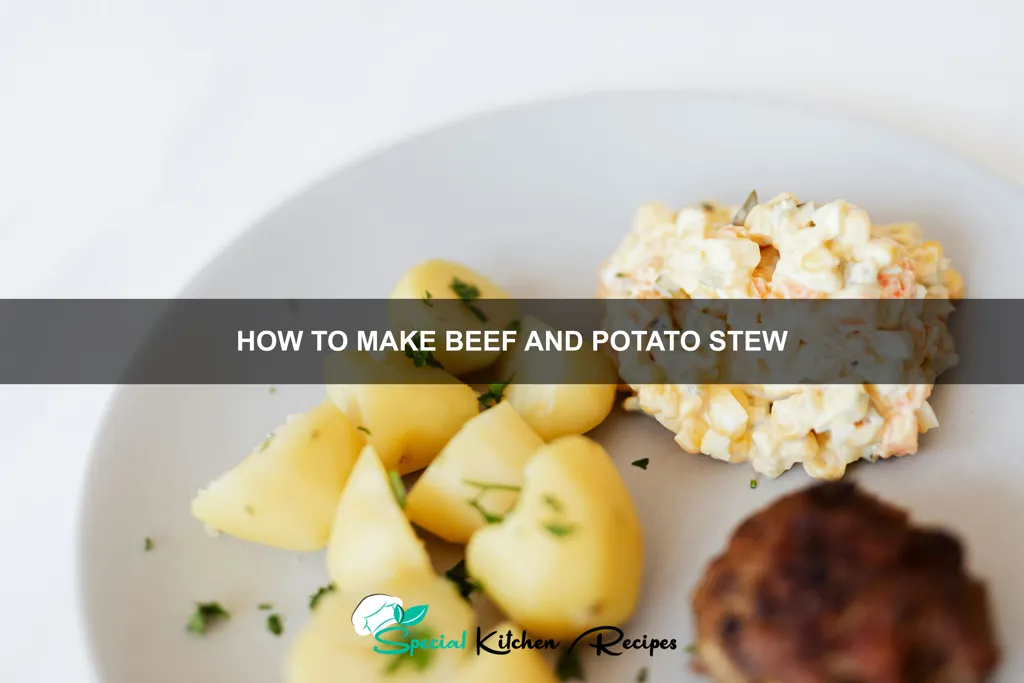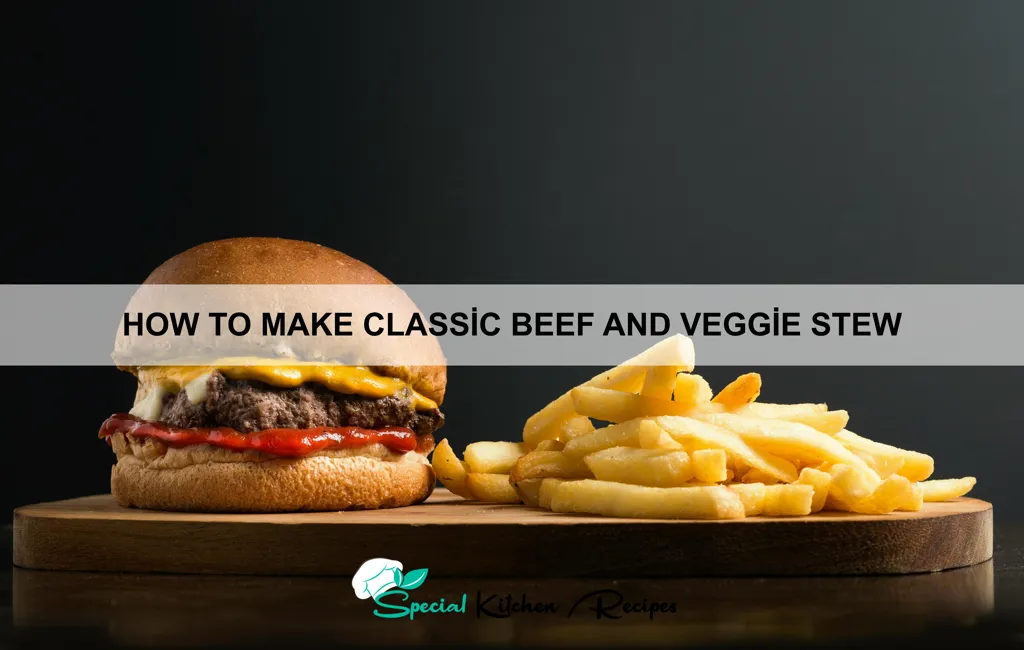Beef and potato stew, a culinary cornerstone across numerous cultures, boasts a history as rich and hearty as its flavor. While pinpointing a single origin is impossible, its fundamental components – beef, potatoes, and a flavorful broth – suggest a long and varied evolution. The dish likely emerged independently in various regions, reflecting local ingredients and cooking traditions. The use of potatoes, introduced to Europe from the Americas in the 16th century, significantly impacted the stew’s development, becoming a key ingredient in many variations. Before the widespread availability of potatoes, root vegetables like turnips or carrots likely filled the role, creating earlier forms of the dish.
In many European countries, particularly those with colder climates, beef and potato stew became a staple winter meal, providing sustenance and warmth. Its simple preparation, using readily available ingredients, contributed to its popularity across various socioeconomic classes. The specific ingredients and cooking methods varied widely based on regional availability and culinary preferences. For example, Irish stew, a well-known variation, emphasizes lamb or mutton instead of beef, reflecting Ireland’s historical reliance on sheep farming. Similar dishes exist throughout Europe and beyond, showcasing the dish’s adaptability and global appeal.
The cultural significance of beef and potato stew is undeniable. It’s often associated with comfort, home-cooked meals, and family traditions. In many cultures, the stew represents a connection to heritage and a celebration of simple, wholesome ingredients. Interestingly, a 2021 survey indicated that beef stew is among the top five most frequently prepared dishes in households across the United Kingdom, highlighting its continued popularity. Beyond its culinary significance, the dish also exemplifies the historical and cultural exchange of ingredients and culinary techniques across the globe, a testament to humanity’s shared love for comforting and nourishing food.
Ingredients and Measurements
This recipe yields approximately 6 servings of hearty Beef and Potato Stew. Accurate measurements are crucial for achieving the perfect consistency and flavor. Use a kitchen scale for the most precise results, especially when measuring the beef and potatoes.
Beef: 1.5 lbs (680g) of beef stew meat, cut into 1-inch cubes. Choosing the right cut is key. Look for cuts that are naturally tougher, as they’ll become incredibly tender during the long simmer. Chuck roast, beef shank, or bottom round are excellent choices. Trim away excess fat, but leave a little bit for flavor.
Potatoes: 2 lbs (900g) of russet potatoes, peeled and cubed into 1-inch pieces. Russets hold their shape well during cooking and provide a creamy texture. Avoid using waxy potatoes like red potatoes, as they tend to fall apart in the stew.
Carrots: 2 large carrots (approximately 8 oz or 225g), peeled and chopped into 1/2-inch thick slices. You can substitute other root vegetables like parsnips or turnips for some of the carrots.
Onions: 1 large yellow onion (approximately 8 oz or 225g), chopped. The onion provides a base for the flavor of the stew. Consider using shallots for a milder, sweeter flavor.
Garlic: 4 cloves of garlic, minced. Freshly minced garlic offers the best flavor. Don’t be shy with the garlic; it complements the beef beautifully.
Liquid: 4 cups (950ml) of beef broth. You can use homemade or store-bought broth. For a richer flavor, use a combination of beef broth and red wine (about 1 cup of red wine).
Aromatics & Seasoning: 2 tablespoons of all-purpose flour, 2 tablespoons of tomato paste, 1 teaspoon of dried thyme, 1 teaspoon of dried rosemary, 1 bay leaf, 1/2 teaspoon of salt, 1/4 teaspoon of black pepper. Adjust seasonings to your taste preference. Fresh herbs are highly recommended if available, but dried herbs work well too.
Optional additions: 1 tablespoon of olive oil for browning the beef, 1 cup of frozen peas added during the last 10 minutes of cooking, a splash of Worcestershire sauce for added depth of flavor.
Note: These measurements are guidelines. Feel free to adjust the quantities to suit your preferences and the number of servings you need.
Preparation Phase: (Includes prepping beef, potatoes, and vegetables)
Begin by preparing the beef. For this recipe, we’ll use approximately 1.5 lbs of beef stew meat, cut into 1-inch cubes. Choose a cut with good marbling for maximum tenderness and flavor. Before proceeding, pat the beef cubes dry with paper towels. This helps achieve a good sear later on. Excess moisture will hinder browning.
Next, tackle the potatoes. We’ll need about 2 lbs of potatoes, such as russet or Yukon gold. Peel them and then cut them into roughly 1-inch cubes. Avoid cutting them too small, as they may disintegrate during the simmering process. Larger pieces will hold their shape better and offer a more satisfying texture.
Now for the vegetables. This recipe calls for a medley of flavors. Start with one large onion, peeled and roughly chopped. A good chop is key here; overly fine chopping will lead to the onions dissolving during the cooking process. Next, add two carrots, peeled and chopped into 1/2-inch thick rounds. Finally, we’ll use two celery stalks, also chopped into 1/2-inch pieces. The combination of onion, carrot, and celery creates a classic mirepoix, a fundamental base for many stews and sauces.
Optional vegetables can be added to enhance the flavor profile of your stew. Consider adding 1 cup of chopped mushrooms, 1 cup of peeled and diced parsnips, or a handful of chopped fresh herbs like thyme or rosemary. Remember to adjust cooking times accordingly if you include additional vegetables.
Once all your ingredients are prepped, it’s a good idea to gather all your other ingredients, such as your broth, seasonings, and any other additions you might be using. Having everything ready before you begin cooking will streamline the process and prevent any interruptions in the cooking flow. This organized approach will ensure consistent results and a more enjoyable cooking experience.
Pro Tip: If you have time, you can season the beef cubes with salt and pepper at least 30 minutes before cooking to allow the flavors to penetrate. This simple step will significantly enhance the beef’s taste.
Sear the Beef
Searing the beef is a crucial step in developing deep, rich flavor in your beef and potato stew. This process creates a flavorful crust on the outside of the meat, adding complexity to the final dish. We’ll be working with approximately 1.5 lbs (680g) of beef stew meat, cut into roughly 1-inch cubes. Before you begin, ensure your beef is completely dry. Pat it down thoroughly with paper towels; excess moisture will hinder the searing process.
Seasoning is key. Generously season the beef cubes with salt and freshly ground black pepper. A good rule of thumb is about 1 teaspoon of salt and ½ teaspoon of black pepper per pound of beef. Don’t be shy! You can also add other seasonings at this stage, such as garlic powder, onion powder, or paprika, to complement the beef’s flavor. About 1 teaspoon of each is a good starting point.
Heat a large, heavy-bottomed pot or Dutch oven over medium-high heat. A heavy pot is essential for even heat distribution, preventing the beef from steaming instead of searing. Add about 2 tablespoons of high-smoke-point oil, such as canola or vegetable oil, to the pot. Let the oil get hot – it should shimmer slightly before adding the beef.
Work in batches to avoid overcrowding the pot. Overcrowding will lower the temperature of the oil, resulting in steaming instead of searing. Add about half of the beef cubes to the hot oil, ensuring they’re not touching each other. Sear for 3-4 minutes per side, until a nice brown crust forms. Use tongs to gently turn the beef, ensuring all sides are seared. Remove the seared beef from the pot and set aside on a plate.
Repeat the searing process with the remaining beef cubes. Don’t wash the pot; the flavorful browned bits (fond) that remain in the pot are essential for building the stew’s rich flavor. Once all the beef is seared, you can proceed with the next steps of the recipe, using the fond as a base for your delicious beef and potato stew.
Professional Tip: For an even deeper flavor, consider adding a tablespoon of tomato paste to the fond after searing the beef. Cook it for a minute or two before adding other ingredients, stirring constantly to prevent burning. This will add a beautiful depth and complexity to your stew.
Building the Stew (Layering Ingredients in the Pot)
The success of a hearty beef and potato stew lies not just in the quality of ingredients but also in the order you introduce them to the pot. Proper layering ensures even cooking and develops rich, complex flavors. We’ll be using a large, heavy-bottomed pot or Dutch oven – approximately 6-8 quarts – for this recipe.
Begin by adding 2 tablespoons of high-quality olive oil to the pot. Place it over medium-high heat. Once hot, add 1.5 lbs of beef stew meat, cut into 1-inch cubes. Sear the beef in batches, ensuring not to overcrowd the pot. This browning process is crucial for developing a deep, savory flavor. Work in batches, ensuring a good sear on all sides of the beef before removing it from the pot and setting it aside on a plate.
Once the beef is seared, reduce the heat to medium. Add 1 large onion, chopped, and 2 carrots, chopped, to the pot. Sauté for about 5-7 minutes, until softened and slightly caramelized. This step adds sweetness and depth to the stew. Then, stir in 2 celery stalks, chopped, and cook for another 2-3 minutes until softened.
Now, it’s time to add the aromatics. Stir in 2 cloves of garlic, minced, and 1 teaspoon of dried thyme. Cook for about 30 seconds, until fragrant. Don’t overcook the garlic, as it can become bitter.
Next, add 3 cups of beef broth (or a combination of broth and water) to the pot. Scrape the bottom of the pot well to loosen any browned bits stuck to the surface – these bits contain lots of flavor!
Return the seared beef to the pot. Add 1.5 lbs of potatoes, peeled and cut into 1-inch cubes. Avoid adding the potatoes too early, as they can become mushy. Stir gently to combine all ingredients.
Finally, season generously with 1 teaspoon of salt and 1/2 teaspoon of black pepper. You can also add other seasonings according to your preference, such as bay leaves or Worcestershire sauce. Bring the stew to a simmer, then reduce the heat to low, cover, and let it simmer gently for at least 1.5 – 2 hours, or until the beef is very tender and the potatoes are cooked through. Stir occasionally to prevent sticking.
Important Note: The cooking time may vary depending on the cut of beef used. For tougher cuts, you may need to simmer for a longer period.
Simmering Techniques
Simmering is crucial for developing the rich, deep flavor of a Beef and Potato Stew. It allows the tough connective tissues in the beef to break down, resulting in tender, melt-in-your-mouth meat. This section details the proper simmering techniques to ensure your stew achieves perfection.
Begin with a good sear: Before simmering, ensure your beef is properly seared. Cut your beef into 1-inch cubes. Heat 2 tablespoons of vegetable oil in a large, heavy-bottomed pot or Dutch oven over medium-high heat. Sear the beef in batches, ensuring not to overcrowd the pot. This process browns the meat, developing a complex flavor and creating a beautiful fond (the browned bits stuck to the bottom of the pot) which adds depth to the stew.
Building the flavor base: After searing the beef, remove it from the pot and set aside. Add 1 chopped onion, 2 chopped carrots, and 2 stalks of celery to the pot and sauté until softened, about 5-7 minutes. This adds sweetness and complexity to the stew’s flavor profile. Don’t rush this step; allowing the vegetables to soften fully enhances the overall taste.
Deglazing the pot: This is a crucial step to incorporate all that delicious fond from the seared beef. Add 1 cup of beef broth to the pot, scraping the bottom with a wooden spoon to loosen any browned bits. This adds intense flavor to the stew. Make sure to scrape thoroughly!
Adding the remaining ingredients: Return the seared beef to the pot. Add 2 lbs of peeled and cubed potatoes, 4 cups of beef broth (or enough to cover the ingredients by about an inch), 1 teaspoon of dried thyme, 1 teaspoon of dried rosemary, 1 bay leaf, and salt and pepper to taste. Ensure the liquid completely submerges the ingredients, adding more broth if necessary.
The simmer: Bring the stew to a gentle simmer over medium heat. Reduce the heat to low, cover the pot, and simmer for at least 2 hours, or until the beef is incredibly tender. Avoid boiling; a gentle simmer is key to preventing the meat from becoming tough and the vegetables from falling apart. Stir occasionally to prevent sticking. For a richer, deeper flavor, consider simmering for 3-4 hours, or even longer, in a slow cooker.
Checking for doneness: The beef should be easily pierced with a fork. If it’s still tough, continue simmering for another 30 minutes to an hour. Taste and adjust seasoning as needed before serving. A splash of Worcestershire sauce or a tablespoon of tomato paste can add extra depth of flavor just before serving.
By following these simmering techniques, you’ll ensure your Beef and Potato Stew is not only delicious but also incredibly tender and flavorful. Enjoy!
Thicken the Stew (if applicable)
Whether or not you need to thicken your beef and potato stew depends largely on your personal preference and the type of potatoes you used. Some potatoes, like russets, break down significantly during cooking, releasing starch and naturally thickening the stew. Others, such as waxy potatoes, retain their shape better, resulting in a thinner final product. If, after simmering, your stew is thinner than desired, thickening is necessary.
There are several excellent methods for thickening beef and potato stew. The simplest and most traditional method is to use a cornstarch slurry. To make this, whisk together 2 tablespoons of cornstarch with 4 tablespoons of cold water in a small bowl until completely smooth. Ensure there are no lumps; lumps will result in a gritty texture.
Once your stew has reached the desired level of doneness, remove about 1 cup of the hot stew from the pot and slowly whisk it into the cornstarch slurry. This tempers the slurry, preventing it from clumping when added to the hot stew. Then, pour the tempered slurry back into the main pot, stirring constantly. Bring the stew to a gentle simmer, stirring frequently, until it thickens to your desired consistency. This usually takes 2-3 minutes. Do not boil vigorously, as this can cause the stew to become gummy.
Another popular method is using a roux. A roux is a mixture of equal parts fat (butter or beef drippings from the stew) and flour. For a medium-thick stew, melt 2 tablespoons of butter in a separate saucepan over medium heat. Whisk in 2 tablespoons of all-purpose flour and cook, stirring constantly, for 1-2 minutes until the mixture is smooth and lightly golden. Do not brown the roux; browning will impart a bitter taste. Gradually whisk the roux into the hot stew, stirring continuously until it thickens.
For a richer, more robust thickening, consider using a mashed potato or a combination of mashed potato and flour. Mash about ½ cup of cooked potatoes until smooth. Stir this into your stew and simmer for a few minutes to allow the flavors to meld. You can also combine this method with a small amount of flour (1-2 tablespoons) for even greater thickening power. Remember to adjust the amount of thickener according to your stew’s consistency and desired thickness. Start with a smaller quantity and add more gradually until you achieve your desired result.
Finally, always taste your stew before serving to ensure the seasoning is balanced after thickening. You may need to add more salt or pepper to compensate for the addition of the thickener.
Recommendations
For the richest flavor, consider browning the beef cubes before adding them to the stew. This step enhances the overall taste and creates a deeper color. Allow the beef to sear properly, ensuring a good crust forms before deglazing the pan with a little red wine or beef broth to capture all those delicious browned bits.
Serving Suggestions: This hearty beef and potato stew is best served hot, ideally with a crusty loaf of bread for dipping. A dollop of sour cream or crème fraîche adds a delightful tangy contrast to the richness of the stew. Consider serving it in individual oven-safe bowls, topped with cheese, and briefly baking for a bubbly, comforting finish.
Storage: Leftover beef and potato stew can be stored in an airtight container in the refrigerator for up to 3-4 days. Allow the stew to cool completely before refrigerating to prevent bacterial growth. Reheat thoroughly before serving. You can also freeze the stew for longer storage; it will keep for up to 3 months in the freezer. Remember to thaw completely in the refrigerator before reheating.
Complementary Dishes: This stew pairs well with a simple green salad to balance the richness of the meat and potatoes. A side of steamed green beans or roasted root vegetables also complements the stew beautifully. For a more substantial meal, consider serving it alongside mashed potatoes or creamy polenta.
Nutritional Information (Approximate per serving, based on a 6-serving recipe): The exact nutritional content will vary depending on the ingredients used. However, a typical serving may contain approximately 400-500 calories, 30-40g of protein, 40-50g of carbohydrates, and 20-25g of fat. This is just an estimate and should be considered a guideline. For a more precise nutritional breakdown, use a nutrition calculator with the exact ingredients and quantities used in your recipe.
Important Note: Always ensure your beef is cooked to a safe internal temperature of 160°F (71°C) to prevent foodborne illness. Use a meat thermometer to guarantee accuracy.





